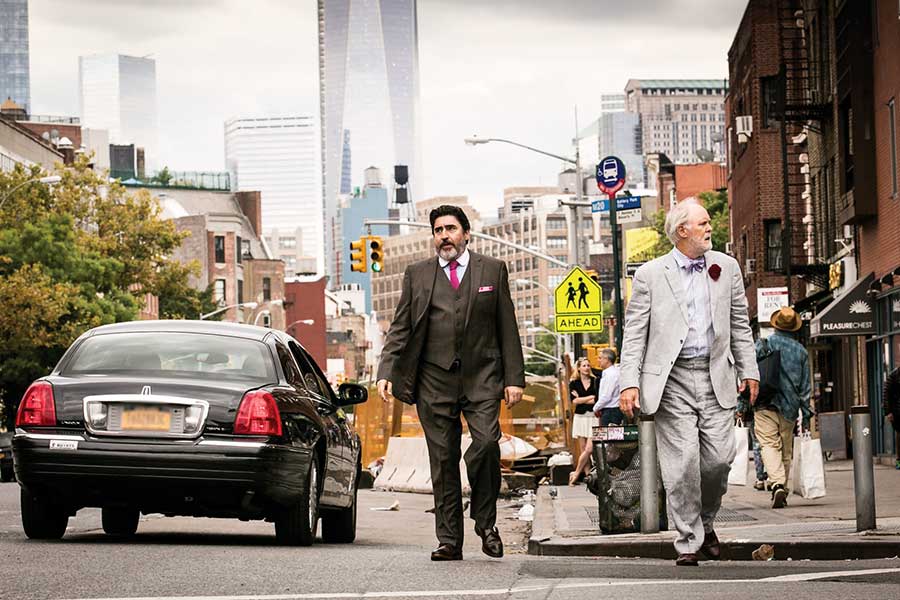“Love Is Strange,” director/co-writer Ira Sachs’ thoughtful, wistful film, opening Sept. 12 at the Ritz, concerns a couple — George (Alfred Molina) and Ben (John Lithgow) — who have been together 39 years. The men marry in the opening moments, but spend most of the rest of the film apart. After (and because of) the wedding, George is fired from his job at a Catholic school, which causes them to lose their apartment.
As a result, George moves in with his downstairs neighbors, Roberto (Manny Perez) and Ted (Cheyenne Jackson), while Ben goes to live with his nephew, Elliot (Darren E. Burrows), his wife, Kate (Marisa Tomei), and their son, Joey (Charlie Tahan).
Watching these men who love each other live apart forms the emotional core of this authentic, observational drama.
“It’s a film about intimacy, and about the possibility of love to grow with time,” the soft-spoken Sachs declared over tea last month at the Marlton Hotel in New York City. “It’s called ‘Love Is Strange’ for a reason: Every intimate relationship is different from the next. Every stage of our lives, we experience love in a different way. This is a film about three generations. Each has a different perspective of love based on their experiences. You have the older couple, the couple in the middle of their lives and this young boy [Joey] finding out about love for the first time.”
The writer/director emphasizes character and mood over plot, a narrative strategy that keeps the audience engaged. A series of lovely scenes depict how George, Ben and their friends and family members interact. From an opening sequence of Ben borrowing money from George and their search for a lost pair of glasses as they head off to get married, to a later scene of the couple reminiscing about their lives together at the bar, Julius, the film contains many authentic moments that will resonate with viewers.
“Love Is Strange” is a personal but not autobiographical film for Sachs. On Jan. 7, 2013, he married painter Boris Torres. They had twins a week later. He said he identifies more with the character of Kate than with either Ben or George.
“She’s me in the sense that she’s in the middle of her life, trying to figure out what the parameters are, and what is possible and what might have to be let go,” Sachs said.
He described his drama as “a film about family and learning to accept the limits of our own lives.” He acknowledged “that we are not here forever is comforting, not depressing. ‘Love Is Strange’ recognizes and values my parents’ generation. It’s very much a middle-age film, a film about my parents — the people I see who are disappearing.”
Sachs beautifully depicts what he calls “the seasons of life” in his film, and he expresses empathy for all his characters. Ben is forced to share a room with Joey, which creates some awkward moments between them (especially when George visits), and leads to a subplot about stolen books that creates a dramatic episode. Kate also becomes irritated by Ben’s presence and the burden of living with him.
“These are good people who can still manage to hurt each other,” Sachs observed about his characters. “That is the texture that I am most interested in, the nuance of intimacy. All my previous films are about the nature of relationships and the likelihood of relationships destroying everyone involved. A lot of my films have been about lies and what is hidden, and for the most part, this is not that film.
“‘Love Is Strange’ is more about responsibility and what we choose to do with other people, how much we are there for the people we are closest to. I really try not to judge anyone in the film, nor myself, for the complicated questions: Who do we take care of? Who do we take in? and, What is our responsibility?”
Sachs’ points about caring and responsibility extend to the depiction of George and Ben’s marriage in the film. Gay marriage here is used more to define the couple’s union and their lives together, and less as a legal act, despite the conflict caused by the Catholic Church.
“You can say that gay marriage is reactionary and avant-garde. I believe it is both,” Sachs said. “I think it’s become such a symbolic point in the discussion around equality that it’s meaningful in the same way that water fountains were in the civil-rights movements. People didn’t really just want to drink water, they just wanted the right to drink water.”
“‘Love Is Strange’ is about two people who face conflict and thus grow stronger together. It’s a drama of separation,” Sachs noted. “What they were separated from was being in bed together, physical intimacy in private space. So when you do see them in bed together, it reveals the history more than anything else.
“It’s a film about the beauty of love. I wanted the audience to get a laser-sharp view of the history of this relationship, and understand in a moment, that it had its passages and its acts. The heart of the film is about intimacy, the structure of building a life together with another human being. Love is not simple, and intimacy is complex.”
